The Effect of COVID-19 on U.S. Mobility: An Analysis of Google Community Mobility Reports#
Abstract#
This study investigates the impact of the COVID-19 pandemic on mobility patterns in the United States using Google Community Mobility Reports. The research employs descriptive statistics, time-series analysis, and regression models to analyze the data. In order to understand the mechanism of epidemic spread on the community mobility, we modelled the demand-service relationship using the DQQ model which analyze disruptions and recoveries in complex systems in different contexts. The model can help decision-makers and practitioners develop strategies to mitigate the impact of disruptions, improve the resilience of systems, and enhance the recovery process. Furthermore, the model can be used to evaluate the effectiveness of different policies and interventions aimed at minimizing disruptions and accelerating the recovery process. The analysis results indicate significant changes in mobility patterns during the pandemic, with notable variations across different regions and sectors. The findings have implications for policymakers and future research on the long-term consequences of the pandemic on human mobility.
Introduction#
The COVID-19 pandemic, caused by the novel coronavirus SARS-CoV-2, has had an unprecedented impact on the lives of people worldwide since its initial outbreak in late 2019. The rapid spread of the virus led to significant disruptions in various sectors, including public health, economy, education, and transportation. Governments around the world implemented various measures to curb the spread of the virus, such as social distancing guidelines, stay-at-home orders, lockdowns, and travel restrictions. These measures significantly altered human behavior and societal norms, leading to widespread changes in mobility patterns.
Understanding the effect of COVID-19 on mobility is essential for several reasons. Firstly, changes in mobility patterns have direct implications for the spread of the virus, as reduced movement and social interactions can help mitigate transmission. Secondly, mobility changes affect economic activity, as restrictions on movement can impact businesses, particularly in sectors such as retail, hospitality, and tourism. Thirdly, the pandemic’s influence on mobility can have lasting social consequences, including changes in work patterns, commuting habits, and urban planning.
Existing studies have examined the effects of the pandemic on mobility patterns, generally indicating significant reductions in travel and movement, particularly during lockdown periods. Google Community Mobility Reports have emerged as a valuable data source for understanding these mobility changes, as they provide daily, anonymized, and aggregated data on movement trends across various categories. (Halford et. al., 2020) examine crime effects for one UK police force area in comparison to 5-year averages. (Nurjani et. al., 2021) study carbon emissions from the transportation sector during the covid-19 pandemic in the special region of yogyakarta, indonesia. The Covid-19 - Google Global Mobility Report was used to map trends of change in the respondents’ activity and mobility. (Trasberg et. al., 2021) find that the activities in the deprived areas dominated by minority groups declined less compared to the Greater London average, leaving those communities more exposed to the virus. (Munawar et. al., 2021) show that transport sector in Australia is facing a serious financial downfall as the use of public transport has dropped by 80%, a 31.5% drop in revenues earned by International airlines in Australia has been predicted, and a 9.5% reduction in the freight transport by water is expected. Federal, state, and local governments have placed multiple executive orders for human mobility reduction to slow down the spread of COVID-19. (Jiang et. al., 2021) use geotagged tweets data to reveal the spatiotemporal human mobility patterns during this COVID-19 pandemic in New York City. (Safitri et. al., 2021) focus on forecasting travel patterns during covid-19 period using community mobility report case study: bangka belitung province. A time series model is necessary to predict future mobility. (Setyowati et. al., 2021) study computer vision syndrome among academic community in mulawarman university, indonesia during work from home in covid-19 pandemic. All the respondents were asked to confirm informed consent to participate . Time series and correlation analysis have been adopted as research protocol utilizing Google community mobility report (CMR) data and the national daily new cases reported by the Ministry of Health (Abdullah, 2021). Other influential work includes (Camba et. al., 2020), (Petersen et. al., 2022). However, more comprehensive research is needed to better understand the factors contributing to these changes and the potential long-term implications of the pandemic on human mobility.
This study aims to assess the effect of COVID-19 on U.S. mobility using Google Community Mobility Reports as a data source. These reports provide daily, anonymized, and aggregated data on movement trends across six categories: retail and recreation, grocery and pharmacy, parks, transit stations, workplaces, and residential areas. By analyzing this data, we seek to provide a comprehensive understanding of the pandemic’s impact on different aspects of mobility and identify factors that contribute to these changes. The findings from this study can inform policymaking and provide valuable insights for future research on the long-term consequences of the pandemic on human mobility.
Data Source#
Descriptive Analysis#
Google Community Mobility Reports provide daily data on mobility trends across six categories: retail and recreation, grocery and pharmacy, parks, transit stations, workplaces, and residential areas. The data is collected from users who have opted-in to location history tracking on their Google accounts.
We selected data from January 2020 to December 2022, representing the pre-pandemic and pandemic periods. The data was cleaned and preprocessed to address missing values and inconsistencies. We aggregated the data at the state level to facilitate regional analysis. The following sections provide the descriptive exploratory data analysis.
from gcmda.utils import mobility_trends_by_date
from gcmda.utils import mobility_trends_by_year_month
from gcmda.utils import mobility_trends_by_category
import numpy as np
import pandas as pd
import matplotlib.pyplot as plt
import seaborn as sns
from sklearn.preprocessing import OneHotEncoder
from sklearn.model_selection import train_test_split
from sklearn.linear_model import LinearRegression
from sklearn.metrics import mean_squared_error
import warnings
warnings.filterwarnings('ignore')
Load the data
US_2020 = pd.read_csv('data/2020_US_Region_Mobility_Report.csv', low_memory=False)
US_2021 = pd.read_csv('data/2021_US_Region_Mobility_Report.csv', low_memory=False)
US_2022 = pd.read_csv('data/2022_US_Region_Mobility_Report.csv', low_memory=False)
Concatenate three dataframes
US_Mobility = pd.concat([US_2020, US_2021, US_2022], ignore_index=True)
US_Mobility.sample(5)
| country_region_code | country_region | sub_region_1 | sub_region_2 | metro_area | iso_3166_2_code | census_fips_code | place_id | date | retail_and_recreation_percent_change_from_baseline | grocery_and_pharmacy_percent_change_from_baseline | parks_percent_change_from_baseline | transit_stations_percent_change_from_baseline | workplaces_percent_change_from_baseline | residential_percent_change_from_baseline | |
|---|---|---|---|---|---|---|---|---|---|---|---|---|---|---|---|
| 1676636 | US | United States | Virginia | Grayson County | NaN | NaN | 51077.0 | ChIJD-JjiS3dUYgRz7gs9ae37CA | 2021-07-30 | NaN | NaN | NaN | NaN | -17.0 | NaN |
| 1397550 | US | United States | North Carolina | Halifax County | NaN | NaN | 37083.0 | ChIJ78ZlU81urokRxogteWGBj0w | 2021-12-19 | 5.0 | -2.0 | NaN | NaN | -23.0 | 3.0 |
| 1592290 | US | United States | Texas | Deaf Smith County | NaN | NaN | 48117.0 | ChIJN3ODW3e7A4cRfTRhqEpDufM | 2021-06-02 | NaN | NaN | NaN | NaN | -26.0 | NaN |
| 695227 | US | United States | Texas | Polk County | NaN | NaN | 48373.0 | ChIJ0bDiw-jyOIYRPrqcrZnzyQc | 2020-05-28 | 7.0 | 20.0 | NaN | -15.0 | -20.0 | 6.0 |
| 389978 | US | United States | Mississippi | Wayne County | NaN | NaN | 28153.0 | ChIJeduQ4weYnIgR9ztNZM26NnY | 2020-05-13 | NaN | NaN | NaN | NaN | -25.0 | NaN |
US_Mobility.info()
<class 'pandas.core.frame.DataFrame'>
RangeIndex: 2511994 entries, 0 to 2511993
Data columns (total 15 columns):
# Column Dtype
--- ------ -----
0 country_region_code object
1 country_region object
2 sub_region_1 object
3 sub_region_2 object
4 metro_area float64
5 iso_3166_2_code object
6 census_fips_code float64
7 place_id object
8 date object
9 retail_and_recreation_percent_change_from_baseline float64
10 grocery_and_pharmacy_percent_change_from_baseline float64
11 parks_percent_change_from_baseline float64
12 transit_stations_percent_change_from_baseline float64
13 workplaces_percent_change_from_baseline float64
14 residential_percent_change_from_baseline float64
dtypes: float64(8), object(7)
memory usage: 287.5+ MB
rename columns and select relevant columns
# rename columns
US_Mobility = US_Mobility.rename(columns = {'sub_region_1': 'state',
'sub_region_2': 'county',
'retail_and_recreation_percent_change_from_baseline': 'retail_and_recreation',
'grocery_and_pharmacy_percent_change_from_baseline':'grocery_and_pharmacy',
'parks_percent_change_from_baseline':'parks',
'transit_stations_percent_change_from_baseline':'transit_stations',
'workplaces_percent_change_from_baseline':'workplaces',
'residential_percent_change_from_baseline':'residential'} )
columns = ['state',
'county',
'date',
'retail_and_recreation',
'grocery_and_pharmacy',
'parks',
'transit_stations',
'workplaces',
'residential']
US_Mobility = US_Mobility[columns]
US_Mobility.sample(5)
| state | county | date | retail_and_recreation | grocery_and_pharmacy | parks | transit_stations | workplaces | residential | |
|---|---|---|---|---|---|---|---|---|---|
| 480870 | New York | Schuyler County | 2020-02-27 | 12.0 | -9.0 | NaN | NaN | 1.0 | NaN |
| 794944 | Wisconsin | Lincoln County | 2020-03-28 | -54.0 | -31.0 | NaN | NaN | -28.0 | NaN |
| 2246499 | Ohio | Athens County | 2022-05-09 | -4.0 | -2.0 | NaN | -43.0 | -23.0 | 3.0 |
| 239645 | Iowa | Webster County | 2020-10-08 | 2.0 | 47.0 | NaN | NaN | -15.0 | 2.0 |
| 2331118 | South Carolina | Williamsburg County | 2022-09-01 | NaN | 5.0 | NaN | NaN | -15.0 | 3.0 |
US_Mobility['year_month'] = US_Mobility['date'].str.rsplit('-', n=1, expand=True).drop(columns=1, axis=1)
US_Mobility['year_month']
0 2020-02
1 2020-02
2 2020-02
3 2020-02
4 2020-02
...
2511989 2022-10
2511990 2022-10
2511991 2022-10
2511992 2022-10
2511993 2022-10
Name: year_month, Length: 2511994, dtype: object
Correlation Analysis#
corr_matrix = US_Mobility.corr(numeric_only=True)
corr_matrix
| retail_and_recreation | grocery_and_pharmacy | parks | transit_stations | workplaces | residential | |
|---|---|---|---|---|---|---|
| retail_and_recreation | 1.000000 | 0.684696 | 0.408976 | 0.551236 | 0.484599 | -0.589351 |
| grocery_and_pharmacy | 0.684696 | 1.000000 | 0.394135 | 0.411115 | 0.324189 | -0.406658 |
| parks | 0.408976 | 0.394135 | 1.000000 | 0.264516 | 0.130495 | -0.309295 |
| transit_stations | 0.551236 | 0.411115 | 0.264516 | 1.000000 | 0.388367 | -0.452145 |
| workplaces | 0.484599 | 0.324189 | 0.130495 | 0.388367 | 1.000000 | -0.773892 |
| residential | -0.589351 | -0.406658 | -0.309295 | -0.452145 | -0.773892 | 1.000000 |
sns.heatmap(corr_matrix, annot=True, cmap='coolwarm');

Spatiotemporal Trends Analysis#
Temporal Trends by Date#
Retail and Recreation#
mobility_trends_by_date(data=US_Mobility, category='retail_and_recreation', plot_title='retail and recreation')
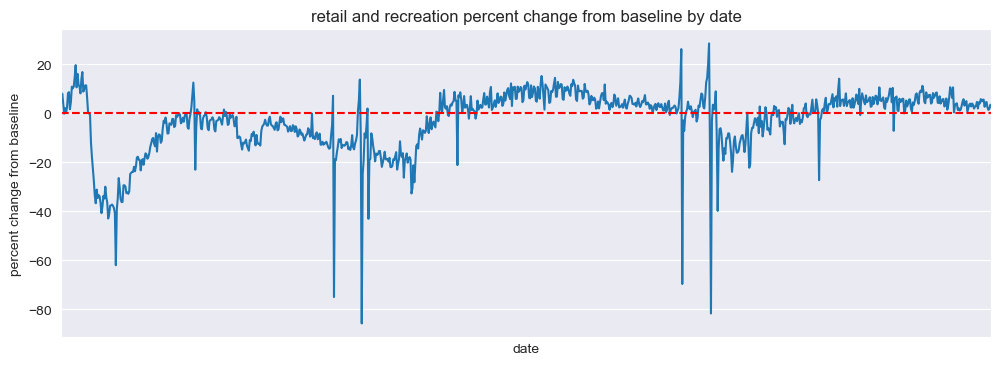
mobility_trends_by_year_month(data=US_Mobility, category='retail_and_recreation', plot_title='retail and recreation')

Parks#
mobility_trends_by_date(data=US_Mobility, category='parks', plot_title='parks')
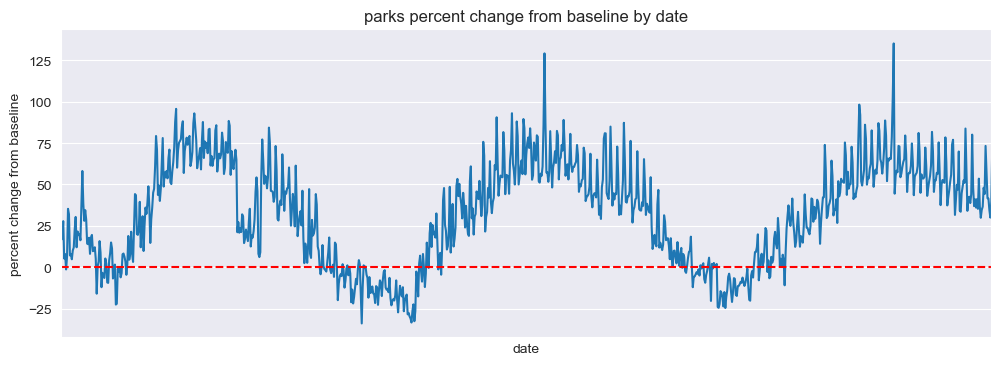
mobility_trends_by_year_month(data=US_Mobility, category='parks', plot_title='parks')
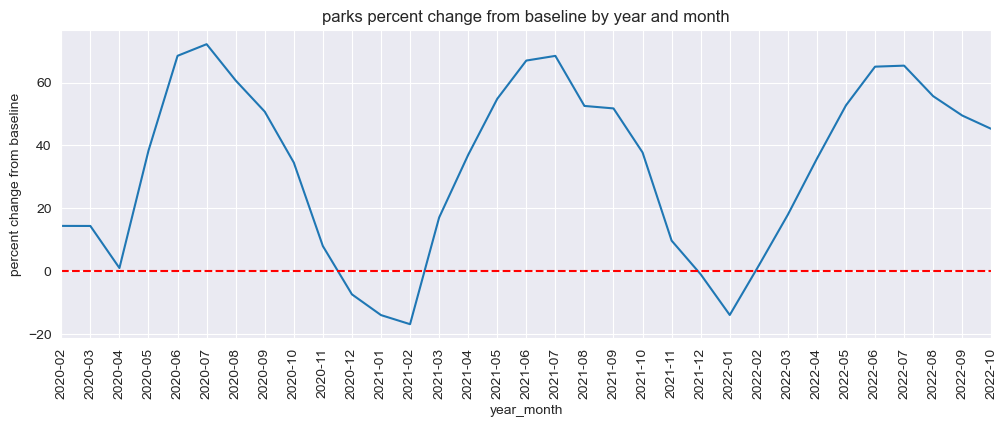
Transit Stations#
mobility_trends_by_date(data=US_Mobility, category='transit_stations', plot_title='transit stations')
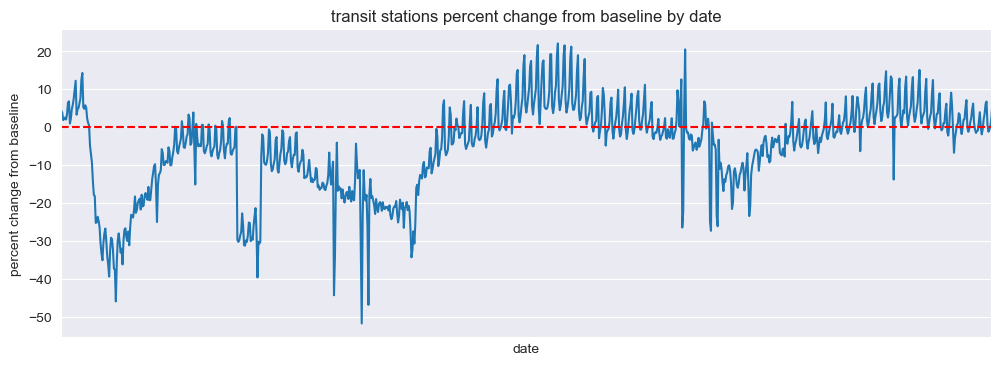
mobility_trends_by_year_month(data=US_Mobility, category='transit_stations', plot_title='transit stations')
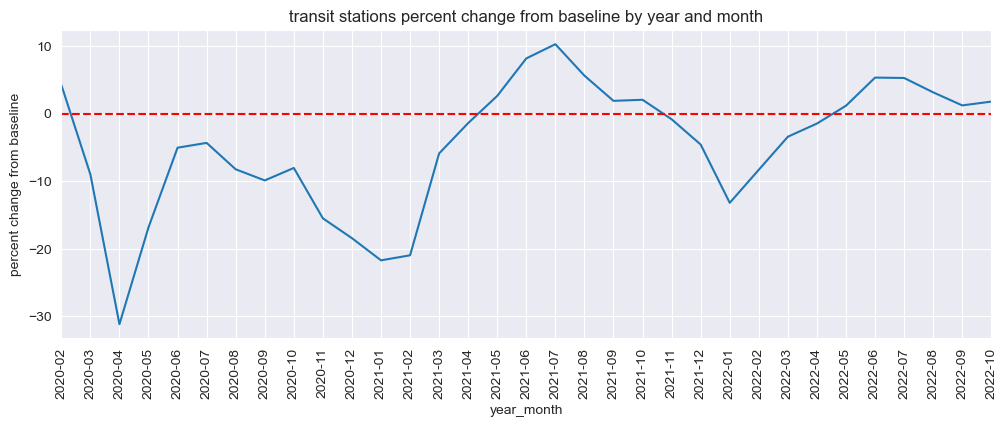
Grocery and Pharmacy#
mobility_trends_by_date(data=US_Mobility, category='grocery_and_pharmacy', plot_title='grocery and pharmacy')
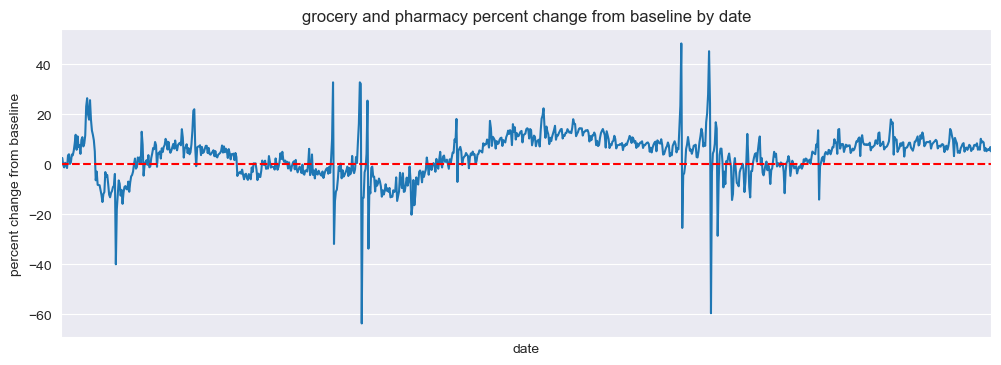
mobility_trends_by_year_month(data=US_Mobility, category='grocery_and_pharmacy', plot_title='grocery and pharmacy')
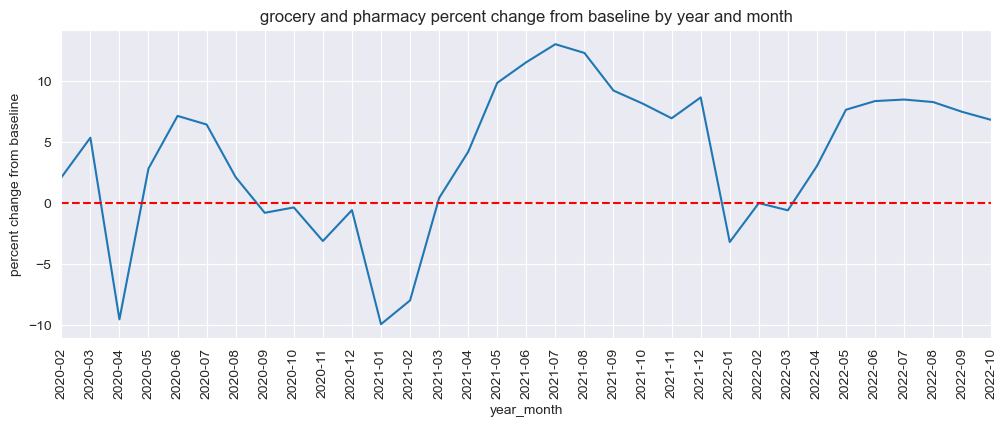
Residential#
mobility_trends_by_date(data=US_Mobility, category='residential', plot_title='residential')
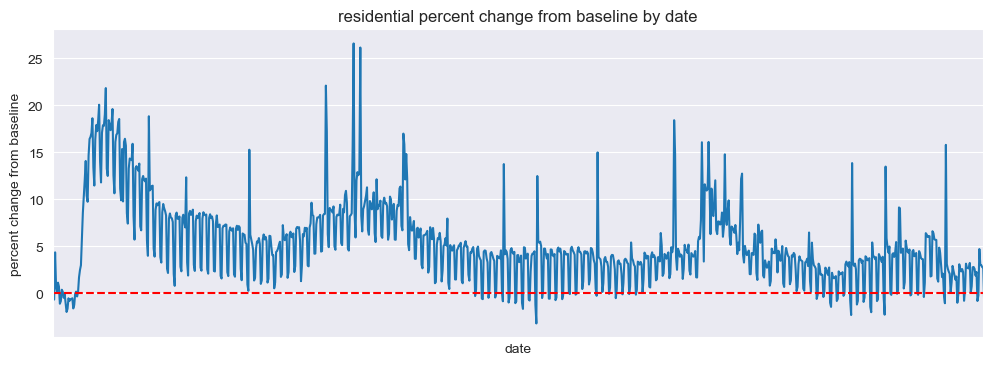
mobility_trends_by_year_month(data=US_Mobility, category='residential', plot_title='residential')
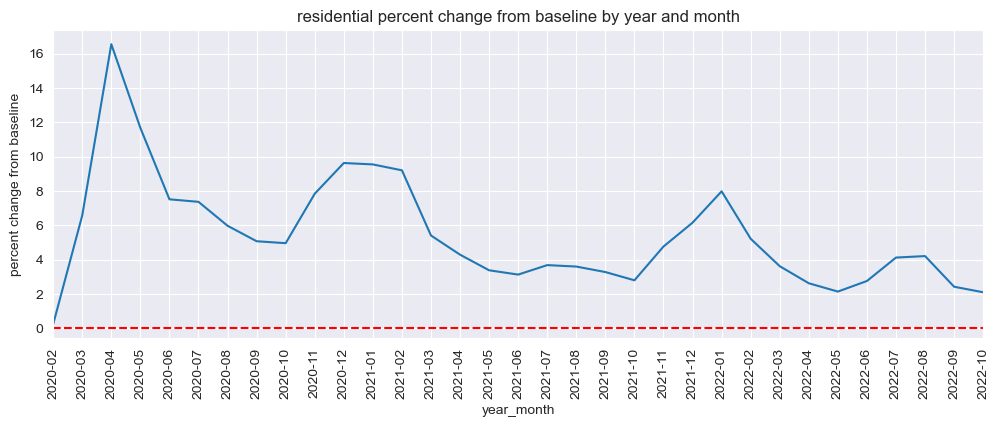
Workplaces#
mobility_trends_by_date(data=US_Mobility, category='workplaces', plot_title='workplaces')
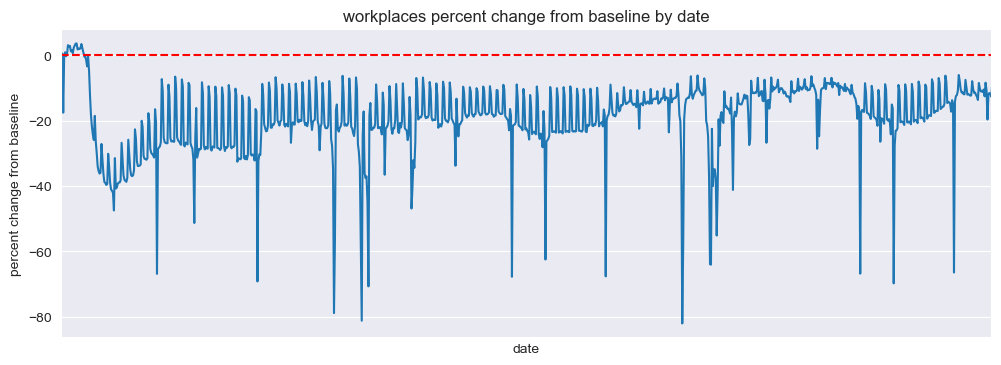
mobility_trends_by_year_month(data=US_Mobility, category='workplaces', plot_title='workplaces')
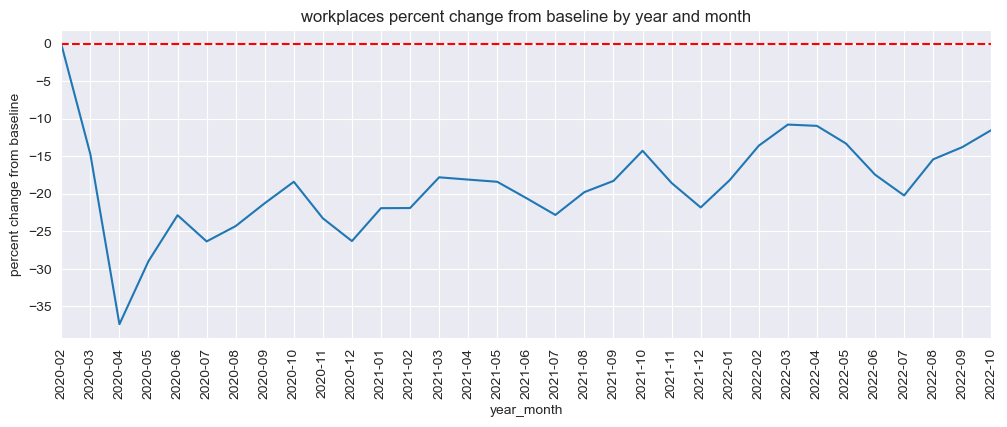
Our analysis revealed significant decreases in mobility across all categories during the pandemic, with the most substantial reductions observed in retail and recreation, transit stations, and workplaces. The residential category experienced increased mobility, reflecting the shift to remote work and stay-at-home orders.
Spatial Trends by State#
Retail and Recreation#
mobility_trends_by_category(data=US_Mobility, category='retail_and_recreation', plot_title='Parks')
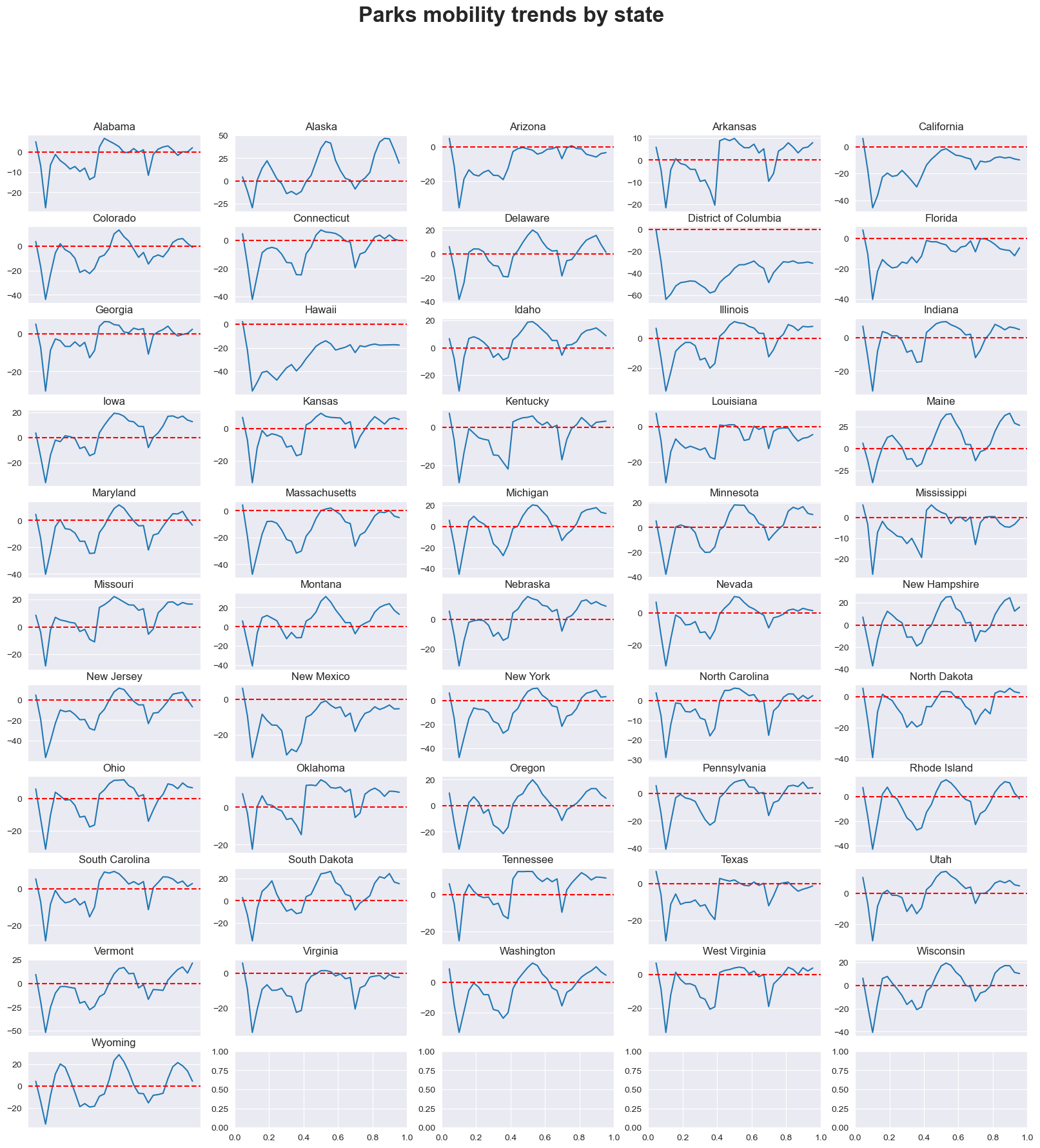
Parks#
mobility_trends_by_category(data=US_Mobility, category='parks', plot_title='Parks')
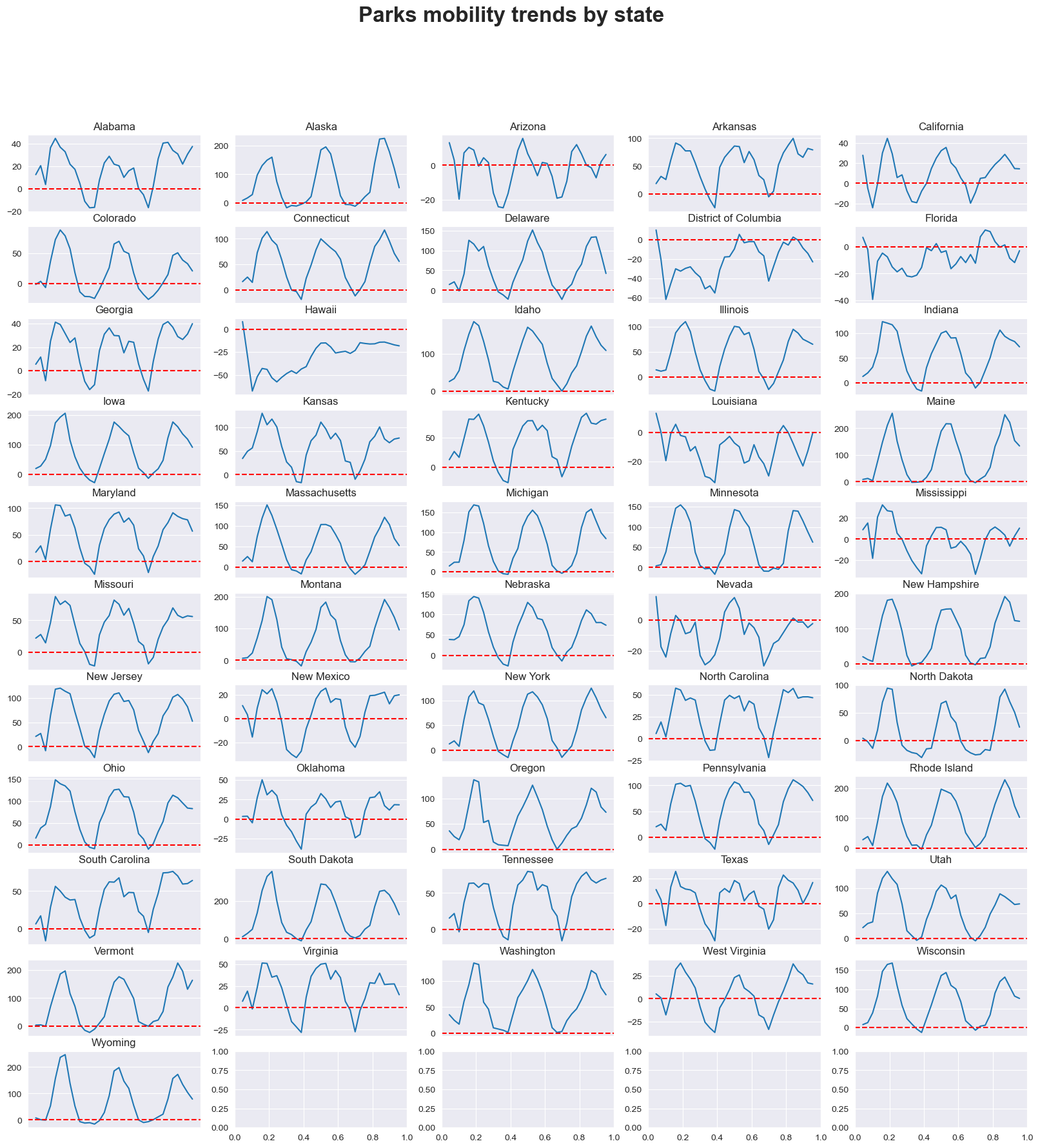
Transit Stations#
mobility_trends_by_category(data=US_Mobility, category='transit_stations', plot_title='Transit Stations')
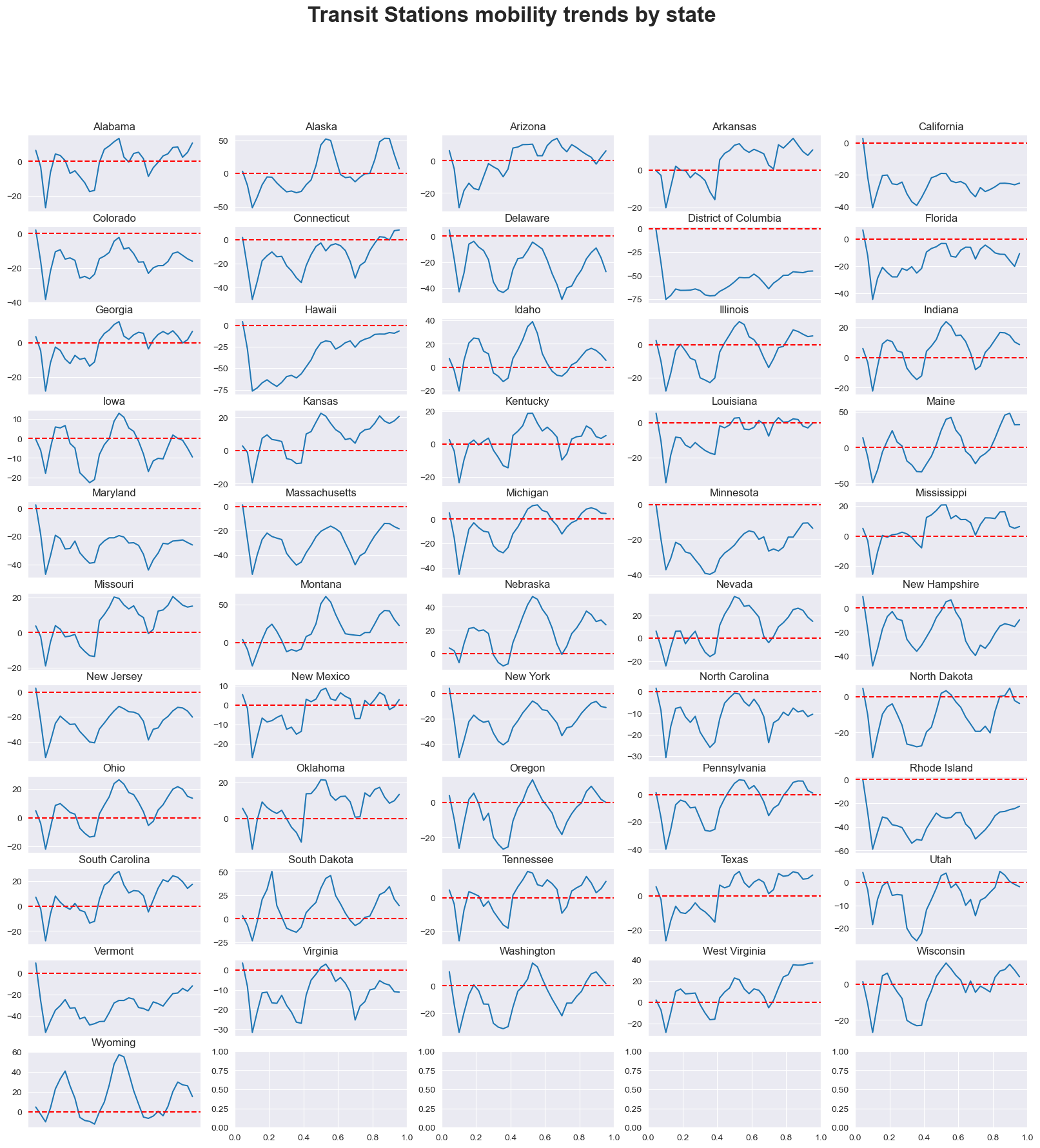
Grocery and Pharmacy#
mobility_trends_by_category(data=US_Mobility, category='grocery_and_pharmacy', plot_title='Grocery and Pharmacy')
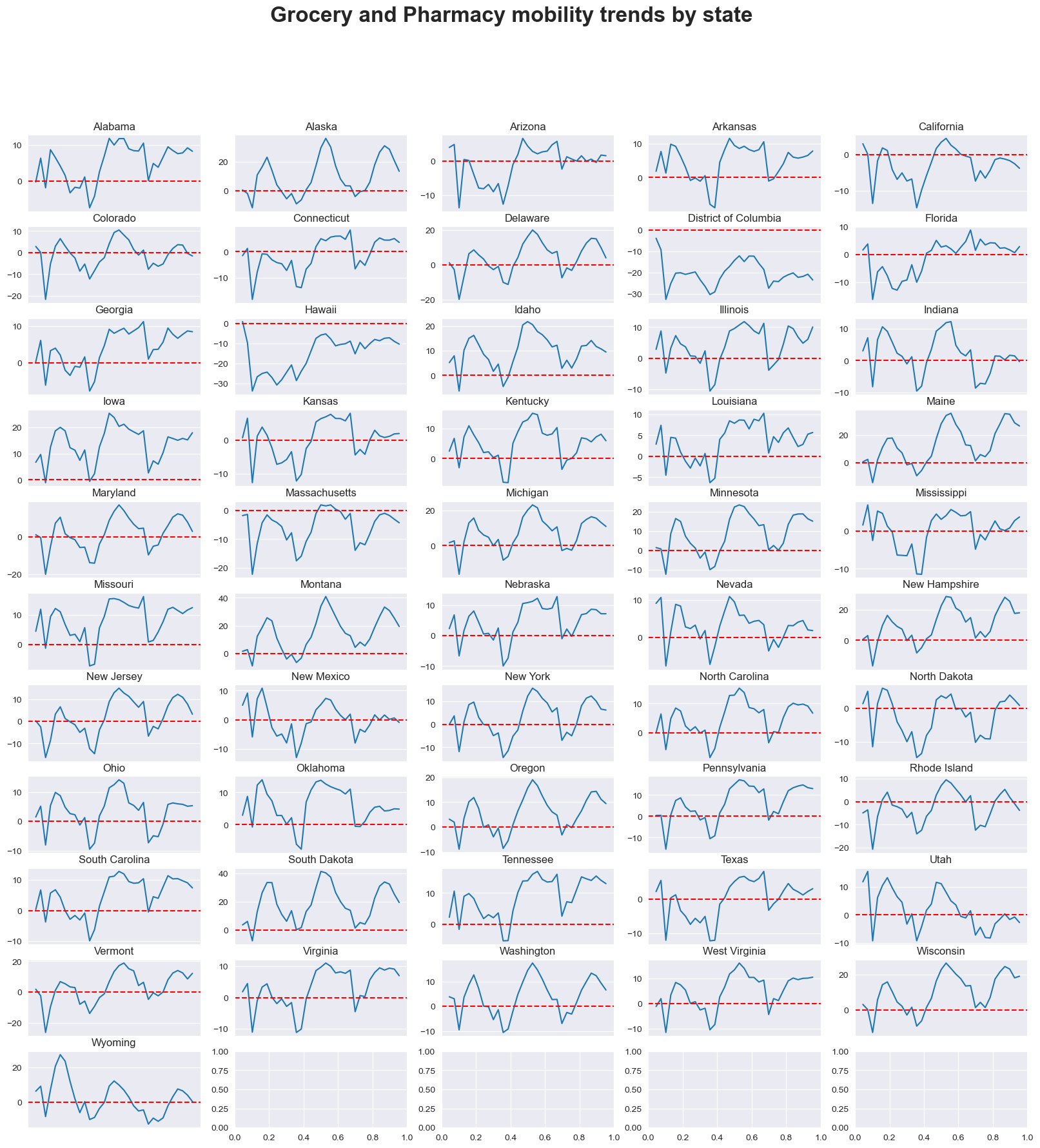
Residential#
mobility_trends_by_category(data=US_Mobility, category='residential', plot_title='Residential')
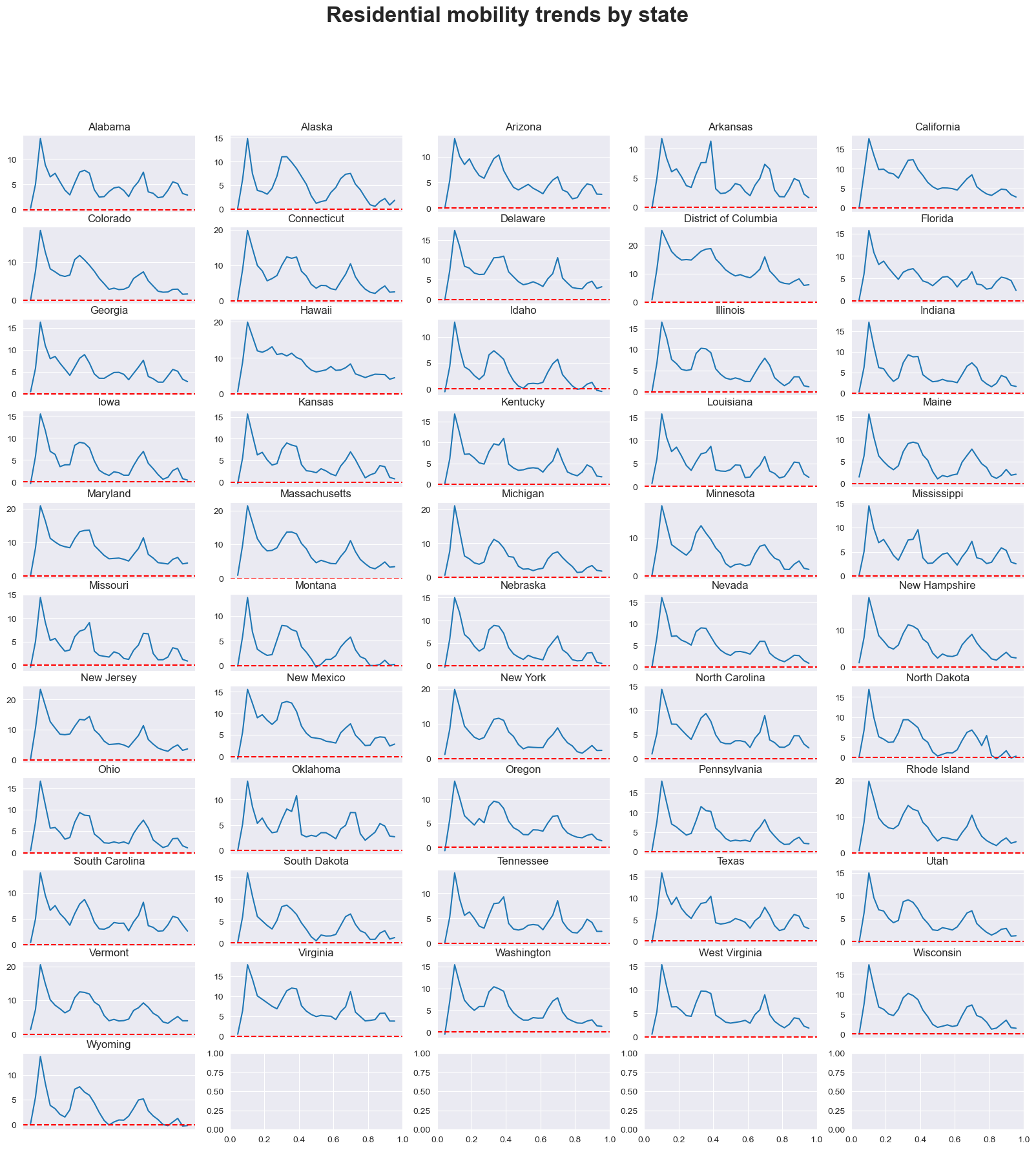
Workplaces#
mobility_trends_by_category(data=US_Mobility, category='workplaces', plot_title='Workplaces')
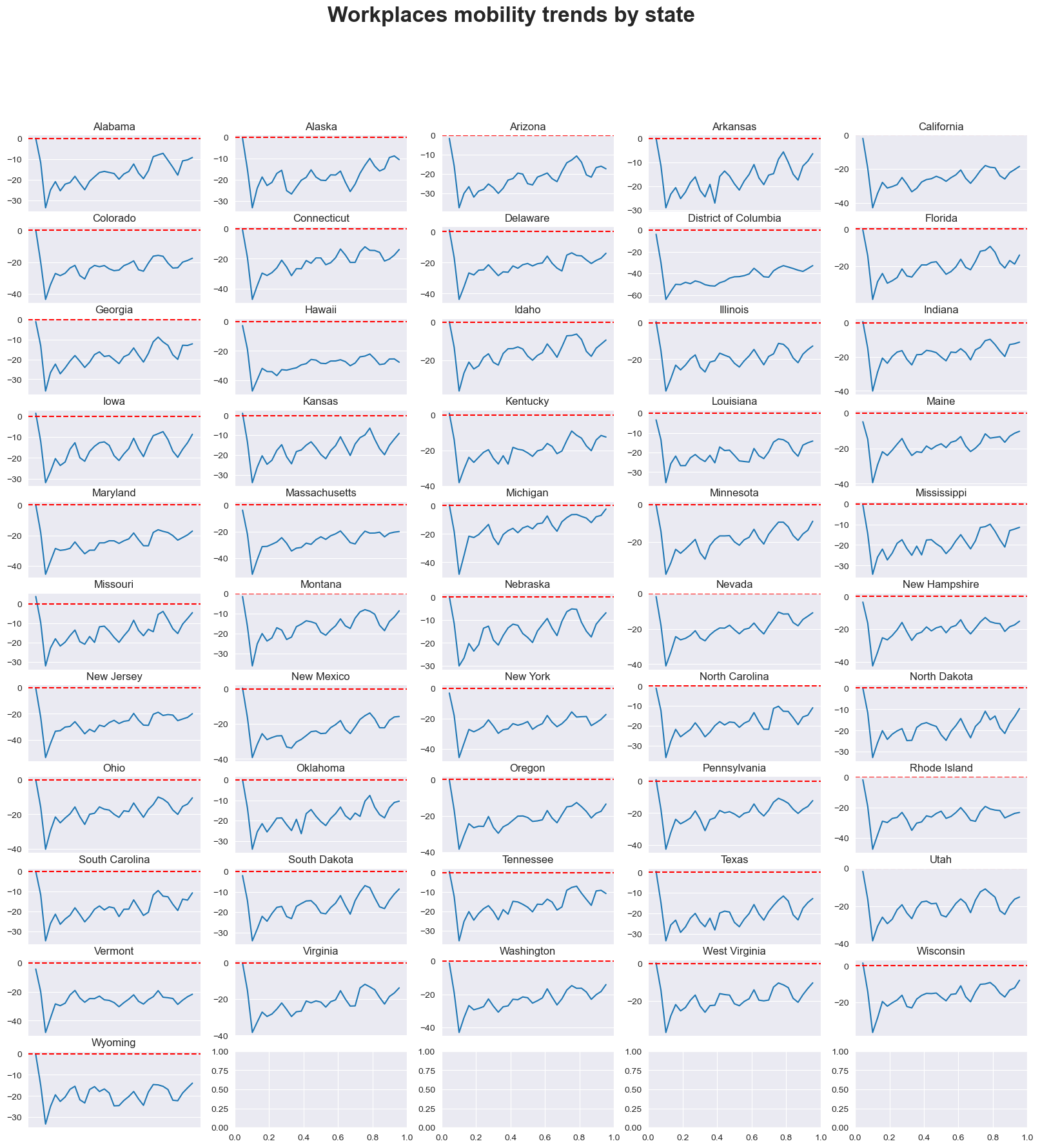
Dependency Analysis#
Analyze covid cases by state#
covid = pd.read_csv("data/covid.csv")
covid = covid[covid["Location"] != "United States"]
covid["COVID_rate (%)"] = 100*(covid["Oct_2020_Cases"] / covid["Total Population"])
covid_sorted = covid.sort_values("COVID_rate (%)", ascending = False)
covid_sorted.head()
fig, ax = plt.subplots(figsize=(20, 10))
sns.barplot(data=covid_sorted, x="Location", y="COVID_rate (%)")
plt.title("covid cases by state")
ax.set_xticklabels(ax.get_xticklabels(), rotation=70);
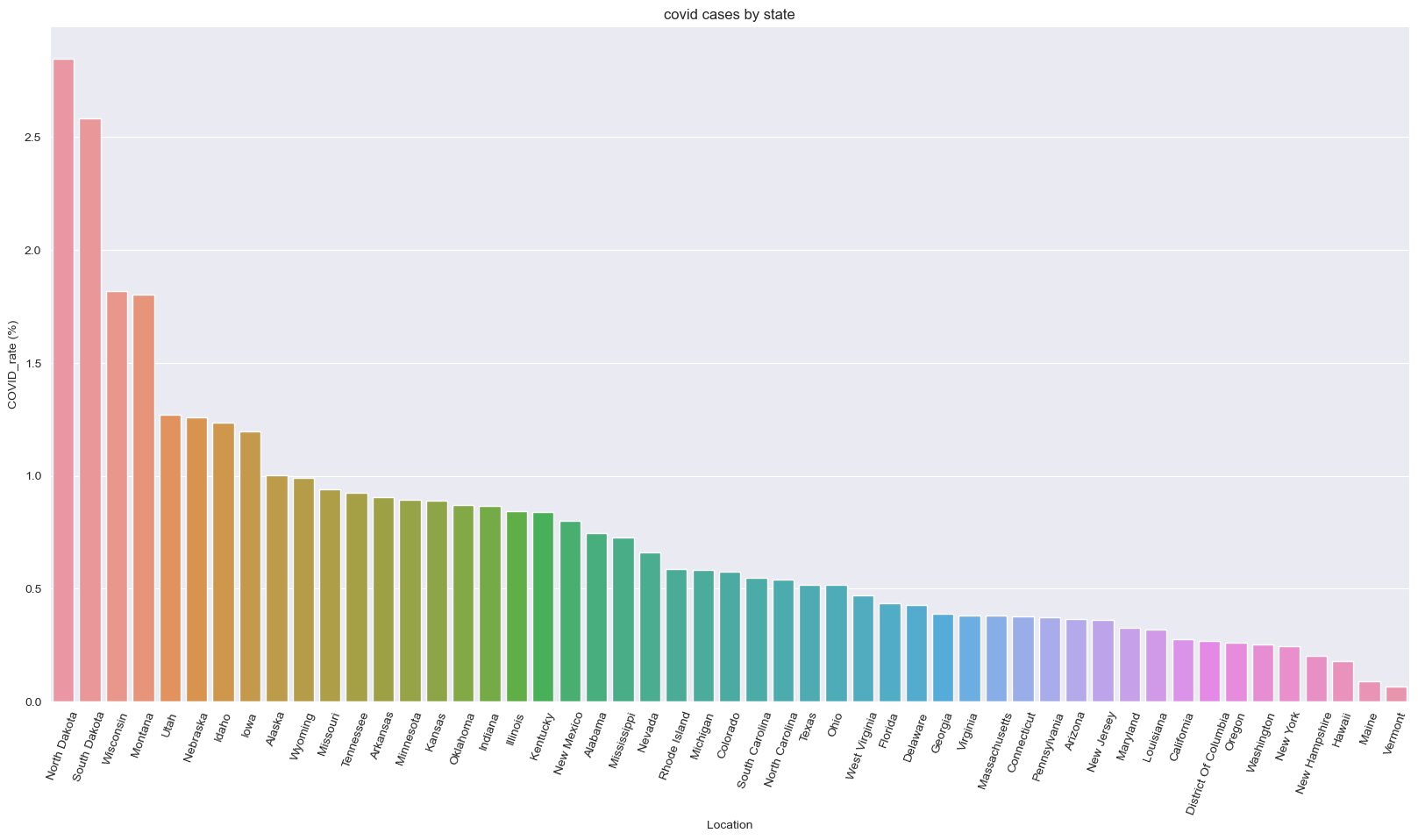
How different gathering bans affect covid affection rate?#
display(covid["Large Gatherings Ban"].unique())
covid_gathering_bans = (pd.DataFrame(covid.groupby("Large Gatherings Ban")["COVID_rate (%)"].mean())
.sort_values("COVID_rate (%)", ascending = False))
covid_gathering_bans
fig, ax = plt.subplots(figsize=(20, 10))
#sns.barplot(data=covid_sorted, x="Location", y="COVID_rate (%)")
ax.set_xticklabels(ax.get_xticklabels(), rotation=70);
sns.violinplot(data=covid, x="Large Gatherings Ban", y="COVID_rate (%)", order=covid_gathering_bans.index)
#sns.lineplot(
# x=covid_gathering_bans.index,
# y=covid_gathering_bans["COVID_rate (%)"],
# style="event"
#)
covid_gathering_bans
array(['No Limit', '>50 Prohibited', 'All Gatherings Prohibited',
'>10 Prohibited', '>25 Prohibited'], dtype=object)
| COVID_rate (%) | |
|---|---|
| Large Gatherings Ban | |
| >50 Prohibited | 0.923554 |
| >25 Prohibited | 0.919531 |
| No Limit | 0.906760 |
| >10 Prohibited | 0.534330 |
| All Gatherings Prohibited | 0.416476 |
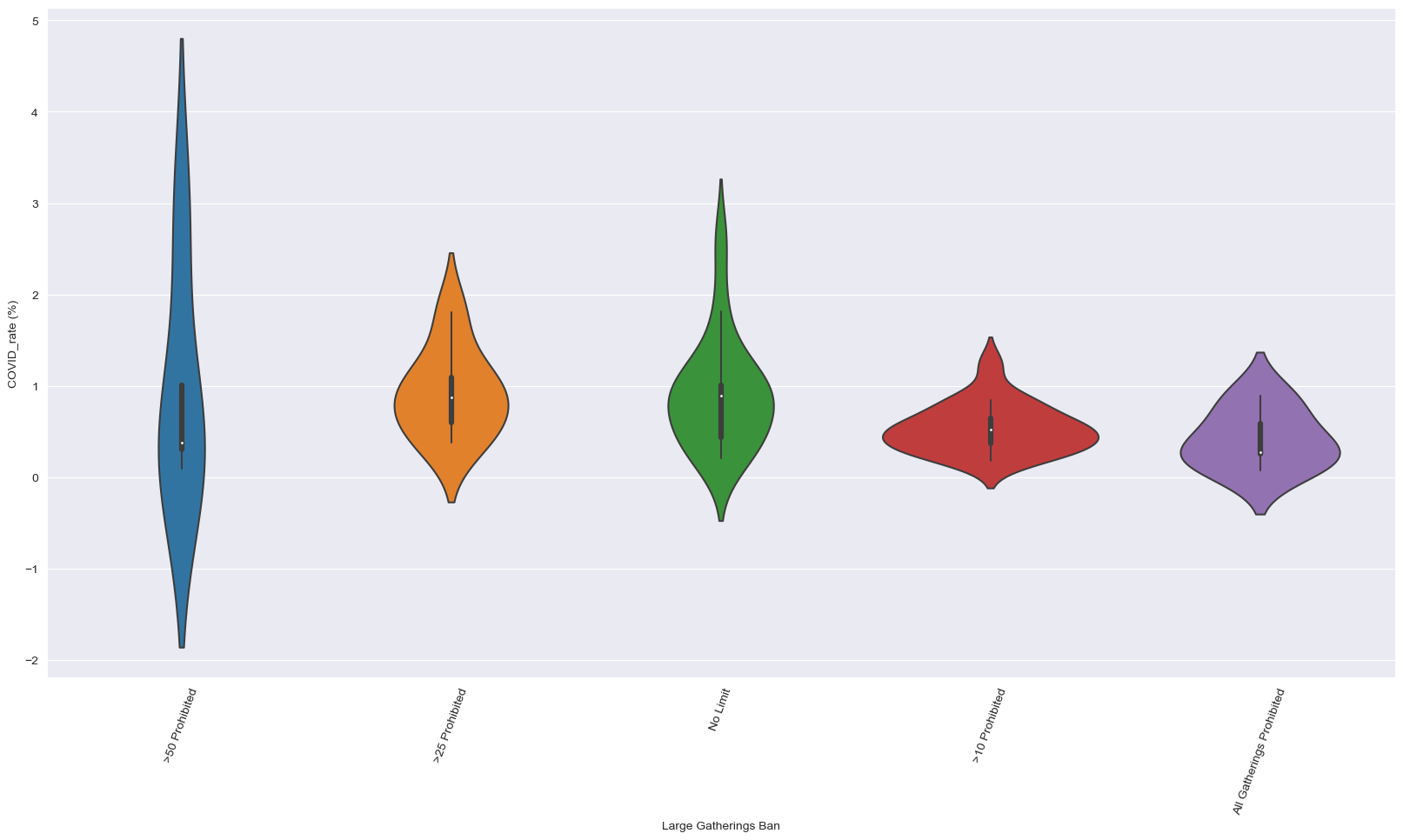
we could see that gathering bans are useful in preventing the spread of COVID
regression covid infection rate on other variables#
features = ["COVID_rate (%)", "Depression.2020", "Employer", "Medicaid", "Medicare", "Uninsured", "Large Gatherings Ban", "Restaurant Limits"]
covid1 = covid[features]
numerical = list((covid1.dtypes[covid1.dtypes == 'float64'].index) | (covid1.dtypes[covid1.dtypes == 'int64'].index))
categorical = list((covid1.dtypes[covid1.dtypes != 'float64'].index) & (covid1.dtypes[covid1.dtypes != 'int64'].index))
categorical
['Large Gatherings Ban', 'Restaurant Limits']
def ohe(data, column):
enc = OneHotEncoder()
enc.fit(data[column])
encoded_data = pd.DataFrame(enc.transform(data[column]).toarray().astype(int))
encoded_data.columns = enc.get_feature_names_out()
encoded_data = encoded_data.set_index(data.index)
return encoded_data
ohe_df = pd.concat([covid1[numerical], ohe(covid1[categorical], categorical)], axis=1)
ohe_df.head()
| COVID_rate (%) | Depression.2020 | Employer | Medicaid | Medicare | Uninsured | Large Gatherings Ban_>10 Prohibited | Large Gatherings Ban_>25 Prohibited | Large Gatherings Ban_>50 Prohibited | Large Gatherings Ban_All Gatherings Prohibited | Large Gatherings Ban_No Limit | Restaurant Limits_- | Restaurant Limits_New Service Limits | Restaurant Limits_Newly Closed to Indoor Dining | Restaurant Limits_Reopened to Dine-in Service | Restaurant Limits_Reopened to Dine-in Service with Capacity Limits | |
|---|---|---|---|---|---|---|---|---|---|---|---|---|---|---|---|---|
| 0 | 0.745250 | 33.8 | 0.469639 | 0.195321 | 0.158831 | 0.101714 | 0 | 0 | 0 | 0 | 1 | 0 | 0 | 0 | 1 | 0 |
| 1 | 1.001716 | 27.1 | 0.481289 | 0.213177 | 0.094280 | 0.120369 | 0 | 0 | 0 | 0 | 1 | 0 | 0 | 0 | 1 | 0 |
| 2 | 0.367290 | 27.2 | 0.444624 | 0.223905 | 0.155921 | 0.106147 | 0 | 0 | 1 | 0 | 0 | 0 | 1 | 0 | 0 | 0 |
| 3 | 0.906918 | 28.3 | 0.418750 | 0.272687 | 0.156044 | 0.082839 | 0 | 0 | 0 | 0 | 1 | 0 | 0 | 0 | 0 | 1 |
| 4 | 0.276735 | 29.7 | 0.473513 | 0.263108 | 0.109437 | 0.071597 | 0 | 0 | 0 | 1 | 0 | 0 | 0 | 0 | 0 | 1 |
X = ohe_df.drop("COVID_rate (%)", axis=1)
y = ohe_df["COVID_rate (%)"]
X_train, X_test, y_train, y_test = train_test_split(X, y, test_size = 0.4, random_state = 0)
model = LinearRegression().fit(X_train, y_train)
print('model intercept :', model.intercept_)
print('model coefficients : ', model.coef_)
print('Training Accuracy: ', model.score(X_train, y_train))
model intercept : 3.8192792490168204
model coefficients : [-0.01522958 -2.86343683 -3.30809215 -3.93673412 2.1371601 -0.03378686
0.4202171 -0.38477096 -0.10947185 0.10781256 1.2697461 -0.22060498
-0.1507367 -0.42249257 -0.47591184]
Training Accuracy: 0.722562928021383
test_predictions = model.predict(X_test)
mean_squared_error(y_test, test_predictions)
0.4365241953146723
Mechanism Analysis based on Demand Modeling#
In order to understand the mechanism of epidemic spread effect on the community mobility change, we modelled the demand-service relationship by proposing the Double Quadratic Queue (DQQ) model.
By adopting the fluid queue derivation process, the model considers the two distinct stages and differentiates itself from a typical single-stage fluid queue model. The fluid queue modeling approach is a method used to analyze and model the behavior of queues in a dynamic setting, taking into account varying arrival and discharge rates. Newell’s approach combines Taylor expansion, calculus, and geometric representation to derive an algebraic expression for the queue length at any given time. The DQQ model incorporates both geometric representation and algebraic expression. This fluid queue process helps visualize the relationships between arrival and discharge rates, queue length, and the passage of time. The ultimate goal of the subsequent derivation process is to obtain an algebraic expression for the queue length or cumulative change, which can be employed to study the queue’s or system’s behavior analytically.

The mathematical expression of the proposed DQQ model is provided in the Appendix A. Typically, the following parameters are observable directly from time series datasets: \(t_0\): the time when epidemic spread starts, \(t_1\): the time when reach the lowest net flow rate, \(t_2\): the time when the net flow rate become 0 first time after \(t_0\), i.e. when the mobility reach the lowest point and start to recover, \(t_3\): the time when the net flow rate reach the highest point, i.e. when the mobility was recovering at the highest speed, \(t_4\): the time when the net flow rate reach and keep at 0, i.e. when the mobility reach the summit equilibrium after epidemic, \(Q_max\): the change in mobility metrics at \(t_2\), i.e. the worst damage caused by epidemic,
In the DQQ model applied in this project, we assume the net flow rate, \(π(t)\), can be represented as double quadratic forms, as shown in the Figure below, which has three intersection points, \(t_0\), \(t_2\), and \(t_4\), with the horizontal axis.
Function util.find_ts provide the process we applied to capture the critical time points and the worst damage caused by epidemic for each state described by the proposed DQQ model. The following codes show the data process and visualization of the DQQ model analysis results.
import matplotlib
matplotlib.rcParams.update({'font.size': 18})
import matplotlib.pyplot as plt
from matplotlib.pyplot import MultipleLocator
from gcmda.utils import find_ts
pd.reset_option("mode.chained_assignment", None)
fig_path = 'figures/dqq_outputs'
out_put_path = 'output'
data_path = 'data'
df = pd.read_csv(f'{data_path}/2020_US_Region_Mobility_Report.csv',
usecols=['sub_region_1', 'date', 'transit_stations_percent_change_from_baseline'])
df.columns = ['state', 'date', 'change_rate']
df['date'] = df.apply(lambda x: x['date'][-5:], axis=1)
df['change_rate'].isnull().sum()
df_full = df.dropna(axis=0, how='any')
state_date = pd.pivot_table(df_full, index='date', columns='state', values='change_rate', aggfunc=np.mean)
US_avg = []
for date_pt, date_df in df_full.groupby('date'):
US_avg.append(date_df['change_rate'].mean())
state_date['US'] = US_avg
state_date['US_rolling'] = state_date['US'].rolling(window=7).mean()
out_put = {
'state': [],
't0': [],
'rate_t0': [],
'day_index_t0': [],
't1': [],
'rate_t1': [],
'day_index_t1': [],
't2': [],
'rate_t2': [],
'day_index_t2': [],
't3': [],
'rate_t3': [],
'day_index_t3': [],
't4': [],
'rate_t4': [],
'day_index_t4': [],
}
for state in state_date.columns:
# for state in ['US', 'Arizona']:
state_date[f'{state}_rolling'] = state_date[f'{state}'].rolling(window=7).mean()
state_date['index_num'] = np.array(range(len(state_date)))
plt.figure(figsize=(16, 12))
if state != 'US':
plt.plot(state_date[f'{state}_rolling'], label=f'{state}', color='orange')
plt.plot(state_date[f'{state}'], alpha=0.1, color='orange')
plt.plot(state_date['US_rolling'], label='US', color='b')
plt.plot(state_date['US'], alpha=0.1, color='b')
y_lim = [min(-60, state_date[f'{state}'].min() - 6), max(30, state_date[f'{state}'].max() + 6)]
text_y = y_lim[0] + 2
plt.ylim(y_lim)
x_lim = [state_date['index_num'].min(), state_date['index_num'].max()]
plt.xlim(x_lim)
ts = find_ts(state_date[[f'{state}', f'{state}_rolling', 'index_num']], state)
plt.scatter(state_date.loc[ts['t0']]['index_num'], ts['rate_t0'], color='r')
plt.scatter(state_date.loc[ts['t1']]['index_num'], ts['rate_t1'], color='r')
plt.scatter(state_date.loc[ts['t2']]['index_num'], ts['rate_t2'], color='r')
plt.scatter(state_date.loc[ts['t3']]['index_num'], ts['rate_t3'], color='r')
plt.scatter(state_date.loc[ts['t4']]['index_num'], ts['rate_t4'], color='r')
plt.annotate(xy=(state_date.loc[ts['t0']]['index_num']-10, text_y),
text=f't0:{ts["t0"]}', rotation=90,
bbox=dict(boxstyle='round,pad=0.5', fc='black', lw=1, alpha=0.12))
plt.annotate(xy=(x_lim[0], ts['rate_t0'] - 4),
text=f'Q(t0)={np.round(ts["rate_t0"], 2)}%',
bbox=dict(boxstyle='round,pad=0.5', fc='black', lw=1, alpha=0.12))
plt.annotate(xy=(state_date.loc[ts['t1']]['index_num']+2.2, text_y),
text=f't1:{ts["t1"]}', rotation=90,
bbox=dict(boxstyle='round,pad=0.5', fc='black', lw=1, alpha=0.12))
plt.annotate(xy=(x_lim[0], ts['rate_t1'] + 1.6),
text=f'Q(t1)={np.round(ts["rate_t1"], 2)}%',
bbox=dict(boxstyle='round,pad=0.5', fc='black', lw=1, alpha=0.12))
plt.annotate(xy=(state_date.loc[ts['t2']]['index_num']+2.2, text_y),
text=f't2:{ts["t2"]}', rotation=90,
bbox=dict(boxstyle='round,pad=0.5', fc='black', lw=1, alpha=0.12))
plt.annotate(xy=(x_lim[0], ts['rate_t2'] + 1.6),
text=f'Q(t2)={np.round(ts["rate_t2"], 2)}%',
bbox=dict(boxstyle='round,pad=0.5', fc='black', lw=1, alpha=0.12))
plt.annotate(xy=(state_date.loc[ts['t3']]['index_num']+2.2, text_y),
text=f't3:{ts["t3"]}', rotation=90,
bbox=dict(boxstyle='round,pad=0.5', fc='black', lw=1, alpha=0.12))
plt.annotate(xy=(x_lim[0], ts['rate_t3'] - 4),
text=f'Q(t3)={np.round(ts["rate_t3"], 2)}%',
bbox=dict(boxstyle='round,pad=0.5', fc='black', lw=1, alpha=0.12))
plt.annotate(xy=(state_date.loc[ts['t4']]['index_num']+2.2, text_y),
text=f't4:{ts["t4"]}', rotation=90,
bbox=dict(boxstyle='round,pad=0.5', fc='black', lw=1, alpha=0.12))
plt.annotate(xy=(x_lim[0], ts['rate_t4'] - 4),
text=f'Q(t4)={np.round(ts["rate_t4"], 2)}%',
bbox=dict(boxstyle='round,pad=0.5', fc='black', lw=1, alpha=0.12))
x_major_locator = MultipleLocator(20)
ax = plt.gca()
ax.xaxis.set_major_locator(x_major_locator)
ax.set_xlabel(state_date.index.tolist())
# dashline for anotations
dashlline_x = [state_date.loc[ts['t0']]['index_num'],
state_date.loc[ts['t1']]['index_num'],
state_date.loc[ts['t2']]['index_num'],
state_date.loc[ts['t3']]['index_num'],
state_date.loc[ts['t4']]['index_num']]
dashlline_y = [ts['rate_t0'], ts['rate_t1'], ts['rate_t2'], ts['rate_t3'], ts['rate_t4']]
ax.vlines(dashlline_x, np.ones(len(dashlline_x)) * y_lim[0], dashlline_y,
linestyles='dashed', colors='red')
ax.hlines(dashlline_y, np.zeros(len(dashlline_x)), dashlline_x,
linestyles='dashed', colors='red')
plt.xticks(rotation=60)
plt.legend()
plt.title(f'Transit Stations Percent Change from Baseline of 2020: {state}')
plt.xlabel('Date')
plt.ylabel('Change Rate (%)')
# plt.show()
plt.savefig(f'{fig_path}/{state}.png', dpi=200)
# print(f'Plotting {state}')
plt.close()
plt.figure(figsize=(12, 8))
if state != 'US':
plt.plot(state_date[f'{state}_rolling'], label=f'{state}', color='orange')
plt.plot(state_date[f'{state}'], alpha=0.1, color='orange')
plt.plot(state_date['US_rolling'], label='US', color='b')
plt.plot(state_date['US'], alpha=0.1, color='b')
plt.ylim(y_lim)
plt.xlim(x_lim)
x_major_locator = MultipleLocator(20)
ax = plt.gca()
ax.xaxis.set_major_locator(x_major_locator)
ax.set_xlabel(state_date.index.tolist())
plt.xticks(rotation=60)
plt.legend()
plt.title(f'Transit Stations Percent Change from Baseline of 2020: {state}')
plt.xlabel('Date')
plt.ylabel('Change Rate (%)')
# plt.show()
plt.savefig(f'{fig_path}/{state}_only_curve.png', dpi=200)
# print(f'Plotting {state}')
plt.close()
dashlline_x = [state_date.loc[ts['t0']]['index_num'],
state_date.loc[ts['t1']]['index_num'],
state_date.loc[ts['t2']]['index_num'],
state_date.loc[ts['t3']]['index_num'],
state_date.loc[ts['t4']]['index_num']]
out_put['state'].append(state)
for t in ['t0', 't1', 't2', 't3', 't4']:
out_put[t].append(ts[t])
out_put[f'rate_{t}'].append(ts[f'rate_{t}'])
out_put[f'day_index_{t}'].append(state_date.loc[ts[t]]['index_num'])
out_put_df = pd.DataFrame(out_put)
out_put_df.to_csv(f'{out_put_path}/dqq_transit_ts.csv')
The full output figure set for each states could be find in figures/dqq_outputs. Here are some examples:

The figure above indicates that the worst mobility drop (-35.51%) in US transit system , \(t_2\), was reached in the middle April. Since then the recovery process start and reached the summited equilibrium (-6.52%) in the middle of June. The second wave of COVID-19 hit US in the interface of July and August, which caused the mobility to further drop and lead to a worse equilibrium later in November.
Let’s compare the pattern of transit with other catagories:
classes = ['retail_and_recreation_percent_change_from_baseline',
'grocery_and_pharmacy_percent_change_from_baseline',
'parks_percent_change_from_baseline',
'transit_stations_percent_change_from_baseline',
'workplaces_percent_change_from_baseline',
'residential_percent_change_from_baseline']
markers = [
'.', '1', 's', '+', 'p', 'v'
]
df = pd.read_csv(f'{data_path}/2020_US_Region_Mobility_Report.csv',
usecols=['sub_region_1', 'date'] + classes)
df.columns = ['state', 'date'] + classes
df['date'] = df.apply(lambda x: x['date'][-5:], axis=1)
df_full = df.dropna(axis=0, how='any')
# for state in state_date.columns:
for state in ['US', 'Arizona']:
plt.figure(figsize=(16, 12))
for i in range(len(classes)):
category = classes[i]
marker = markers[i]
state_date = pd.pivot_table(df_full, index='date', columns='state', values=category, aggfunc=np.mean)
US_avg = []
for date_pt, date_df in df_full.groupby('date'):
US_avg.append(date_df[category].mean())
state_date['US'] = US_avg
state_date['US_rolling'] = state_date['US'].rolling(window=7).mean()
state_date[f'{state}_rolling'] = state_date[f'{state}'].rolling(window=7).mean()
state_date['index_num'] = np.array(range(len(state_date)))
if category[0:7] == "transit":
plt.plot(state_date[f'{state}_rolling'], label=f'{state}_{category.split("_percent")[0]}', linewidth=6)
plt.plot(state_date[f'{state}'], alpha=0.06)
ts = find_ts(state_date[[f'{state}', f'{state}_rolling', 'index_num']], state)
plt.scatter(state_date.loc[ts['t0']]['index_num'], ts['rate_t0'], color='r', s=10)
plt.scatter(state_date.loc[ts['t1']]['index_num'], ts['rate_t1'], color='r', s=10)
plt.scatter(state_date.loc[ts['t2']]['index_num'], ts['rate_t2'], color='r', s=10)
plt.scatter(state_date.loc[ts['t3']]['index_num'], ts['rate_t3'], color='r', s=10)
plt.scatter(state_date.loc[ts['t4']]['index_num'], ts['rate_t4'], color='r', s=10)
y_lim = [min(-60, state_date[f'{state}'].min() - 10), max(30, state_date[f'{state}'].max() + 80)]
text_y = y_lim[0] + 3
plt.ylim(y_lim)
plt.annotate(xy=(state_date.loc[ts['t0']]['index_num'] - 10, text_y),
text=f't0:{ts["t0"]}', rotation=90,
bbox=dict(boxstyle='round,pad=0.5', fc='black', lw=1, alpha=0.12))
plt.annotate(xy=(state_date.loc[ts['t1']]['index_num'] + 2.2, text_y),
text=f't1:{ts["t1"]}', rotation=90,
bbox=dict(boxstyle='round,pad=0.5', fc='black', lw=1, alpha=0.12))
plt.annotate(xy=(state_date.loc[ts['t2']]['index_num'] + 2.2, text_y),
text=f't2:{ts["t2"]}', rotation=90,
bbox=dict(boxstyle='round,pad=0.5', fc='black', lw=1, alpha=0.12))
plt.annotate(xy=(state_date.loc[ts['t3']]['index_num'] + 2.2, text_y),
text=f't3:{ts["t3"]}', rotation=90,
bbox=dict(boxstyle='round,pad=0.5', fc='black', lw=1, alpha=0.12))
plt.annotate(xy=(state_date.loc[ts['t4']]['index_num'] + 2.2, text_y),
text=f't4:{ts["t4"]}', rotation=90,
bbox=dict(boxstyle='round,pad=0.5', fc='black', lw=1, alpha=0.12))
# dashline for anotations
dashlline_x = [state_date.loc[ts['t0']]['index_num'],
state_date.loc[ts['t1']]['index_num'],
state_date.loc[ts['t2']]['index_num'],
state_date.loc[ts['t3']]['index_num'],
state_date.loc[ts['t4']]['index_num']]
dashlline_y = [ts['rate_t0'], ts['rate_t1'], ts['rate_t2'], ts['rate_t3'], ts['rate_t4']]
x_major_locator = MultipleLocator(20)
ax = plt.gca()
ax.xaxis.set_major_locator(x_major_locator)
ax.set_xlabel(state_date.index.tolist())
ax.vlines(dashlline_x, np.ones(len(dashlline_x)) * y_lim[0], np.ones(len(dashlline_x)) * y_lim[1],
linestyles='dashed', colors='red')
else:
plt.plot(state_date[f'{state}_rolling'], label=f'{state}_{category.split("_percent")[0]}', marker=marker, markersize=10, markevery=10)
plt.plot(state_date[f'{state}'], alpha=0.06)
x_major_locator = MultipleLocator(20)
ax = plt.gca()
ax.xaxis.set_major_locator(x_major_locator)
ax.set_xlabel(state_date.index.tolist())
plt.xticks(rotation=60)
plt.legend(loc='upper right')
plt.title(f'Percent Change from Baseline of 2020: {state}')
plt.xlabel('Date')
plt.ylabel('Change Rate (%)') # change font size: fontsize=20
# plt.show()
plt.savefig(f'{fig_path}/{state}_multi_category.png', dpi=200)
plt.close()
Here is the plot of transit DQQ time points compare to other categories:
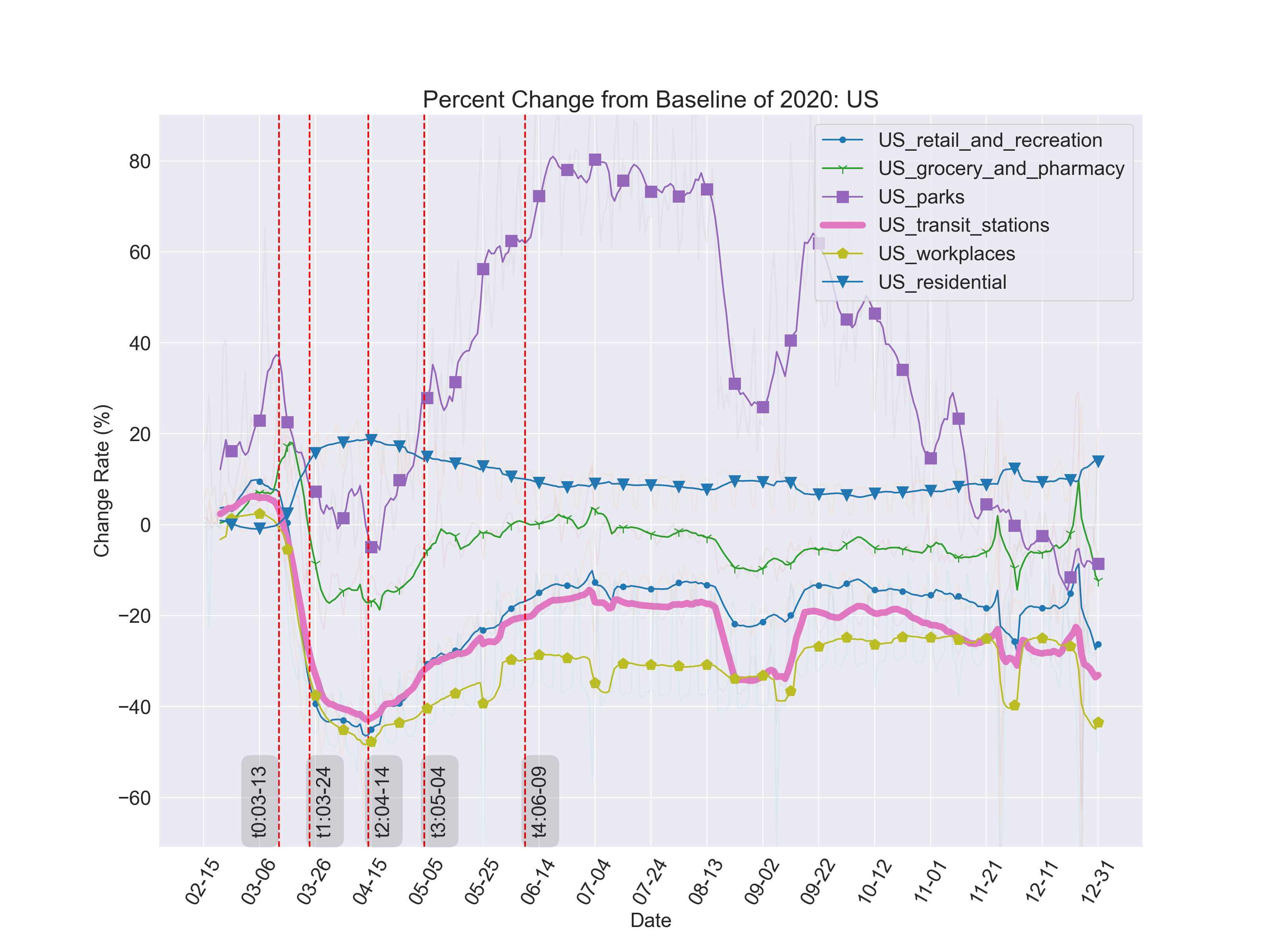
As shown in the figure, the similar pattern of DQQ could be observed in all categories other than the residential and parks, which has increased value of citizen density since the remote working.
Conclusion#
This study contributes to the understanding of the effect of COVID-19 on U.S. mobility patterns by providing a comprehensive analysis of Google Community Mobility Reports data across various mobility categories. The findings demonstrate the pandemic’s significant and varied impact on different aspects of mobility, with implications for policymakers and future research on the long-term consequences of the pandemic on human mobility.
Our analysis revealed that the retail and recreation, transit stations, and workplaces categories experienced the most substantial reductions in mobility during the pandemic. These sectors were highly vulnerable to the effects of social distancing measures and lockdowns. In contrast, the residential category saw increased mobility as people adapted to remote work and stay-at-home orders.
The time-series analysis demonstrated a strong association between mobility changes and key pandemic events, such as lockdowns and reopening phases. However, mobility patterns exhibited a high degree of variation across states and over time, reflecting differing policy responses and regional characteristics. This highlights the importance of considering regional variations when designing policies and interventions to address the pandemic’s impact on mobility.
As the COVID-19 pandemic continues to evolve, it is crucial to monitor mobility trends and adapt policies accordingly. Future research could explore the long-term implications of the pandemic on mobility, such as potential shifts in work-from-home policies, urban planning, and transportation infrastructure. Additionally, examining the role of vaccination campaigns in shaping mobility trends can provide valuable insights for policymakers as they navigate the ongoing pandemic and its aftermath.
In order to understand the mechanism of epidemic spread on the community mobility, we modelled the demand-service relationship using the DQQ model which analyze disruptions and recoveries in complex systems in different contexts, such as the impact of natural disasters, pandemic outbreaks, and other major events. The model can help decision-makers and practitioners develop strategies to mitigate the impact of disruptions, improve the resilience of systems, and enhance the recovery process. Furthermore, the model can be used to evaluate the effectiveness of different policies and interventions aimed at minimizing disruptions and accelerating the recovery process.
In conclusion, this study offers a comprehensive analysis of the effect of COVID-19 on U.S. mobility patterns using Google Community Mobility Reports data. The findings underscore the pandemic’s significant and multifaceted impact on various aspects of mobility, emphasizing the importance of tailored policy interventions and continued research to better understand and address the long-term consequences of the pandemic on human mobility.
Contribution statement#
Lei Zhang:
prepared / cleaned data for analysis
conducted mobility trends correlation analysis
conducted mobility trends by date analysis
conducted mobility trends by year_month analysis
conducted mobility trends by state analysis
created
utils.pyfile
June Lee:
Social Productivity-Related Mobility TrendsSectionAnalyzed
residentialandworkplacespartMake
Makefilefixed
utils.pyfileCreated
contribution-statement.mdfileFixed binder link
Haoyu Liu:
Dependency AnalysisSectionAnalyzed the relationship of COVID cases and gathering bans (
CasesAndPolicies.ipynb).Made environment
Created Jupyter Book
Added
README.mdfileCreated binder link
Contributed to
main.ipynb
Han Wang:
Introduction,Mechanic Analysis based on Demand Modeling,ConclusionSectionsDetermined the dataset and topic, and organized the structure of the project
Analyzed the state-of-the-art researches and composed the literature review
Proposed the DQQ model for the mechanism analysis
Publish the jupyter book and set up the continuous integration
Set up the LICENSE
References#
[1] Abraham C. Camba; Aileen L. Camba; “The Effects of Restrictions in Economic Activity on The Spread of COVID-19 in The Philippines: Insights from Apple and Google Mobility Indicators”, THE JOURNAL OF ASIAN FINANCE, ECONOMICS AND BUSINESS, 2020.
[2] Eric Halford; Anthony Dixon; Graham Farrell; Nicolas Malleson; Nick Tilley; “Crime and Coronavirus: Social Distancing, Lockdown, and The Mobility Elasticity of Crime”, CRIME SCIENCE, 2020. (IF: 3)
[3] E Nurjani; K P Hafizha; D Purwanto; F Ulumia; M Widyastuti; A B Sekaranom; U Suarma; “Carbon Emissions from The Transportation Sector During The Covid-19 Pandemic in The Special Region of Yogyakarta, Indonesia”, IOP CONFERENCE SERIES: EARTH AND ENVIRONMENTAL SCIENCE, 2021.
[4] Terje Trasberg; James Cheshire; “Spatial and Social Disparities in The Decline of Activities During The COVID-19 Lockdown in Greater London”, URBAN STUDIES, 2021. (IF: 3) [5] Hafiz Suliman Munawar; Sara Imran Khan; Zakria Qadir; Abbas Z. Kouzani; M. A. Parvez Mahmud; “Insight Into The Impact of COVID-19 on Australian Transportation Sector: An Economic and Community-Based Perspective”, SUSTAINABILITY, 2021. (IF: 3)
[6] Yuqin Jiang; Xiao Huang; Zhenlong Li; “Spatiotemporal Patterns of Human Mobility and Its Association with Land Use Types During COVID-19 in New York City”, ISPRS INT. J. GEO INF., 2021. (IF: 3)
[7] R Safitri; R Amelia; “Forecasting Travel Patterns During COVID-19 Period Using Community Mobility Report Case Study: Bangka Belitung Province”, IOP CONFERENCE SERIES: EARTH AND ENVIRONMENTAL SCIENCE, 2021.
[8] Dina Lusiana Setyowati; Muhammad Khairul Nuryanto; Muhammad Sultan; Lisda Sofia; Suwardi Gunawan; Agus Wiranto; “COMPUTER VISION SYNDROME AMONG ACADEMIC COMMUNITY IN MULAWARMAN UNIVERSITY, INDONESIA DURING WORK FROM HOME IN COVID-19 PANDEMIC”, ANNALS OF TROPICAL MEDICINE AND PUBLIC HEALTH, 2021.
[9] Aziman Abdullah; “Lockdown Duration-based Impact Analysis Model of Residential Community Mobility Change and COVID-19 Cases in Malaysia”, 2021 INTERNATIONAL CONFERENCE ON INNOVATION AND …, 2021.
[10] Finn Petersen; Anna Errore; Pinar Karaca-Mandic; “Lifting Statewide Mask Mandates and COVID-19 Cases: A Synthetic Control Study”, MEDICAL CARE, 2022.

Social Productivity-Related Mobility Trends#
Increased mobility as people spent more time at home due to remote work and stay-at-home orders.
We assumed that there will be relation between residential and workplaces categories since if people work at home, the residential mobility will increase and the workplaces mobility will decrease. Calculating the correlation coefficient between residential category and workplaces category, the value was -0.83 which is quite high. This means that as the residential mobility increases, the workplaces mobility decreases or as the residential mobility decreases, the workplaces mobility increases with quite high rate. This makes sense with our assumption of the relation between residential and workplaces mobility trend.
In this section we inspect the correlation between the social productivity-related mobility drop with the viruses transmission situation estimated by the number of cases, using the workplace and residential mobility data as instance.
115 2020-02 116 2020-02 117 2020-02 118 2020-02 119 2020-02 ... 53033 2022-10 53034 2022-10 53035 2022-10 53036 2022-10 53037 2022-10 Name: year_month, Length: 52923, dtype: objectarray([[ 1. , -0.82579813], [-0.82579813, 1. ]])